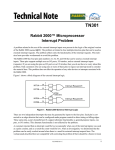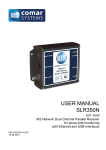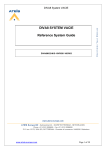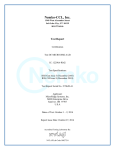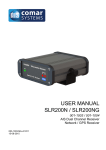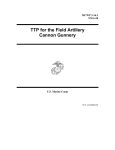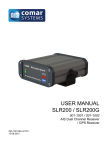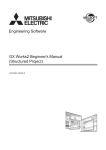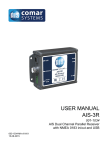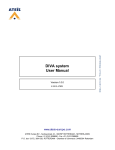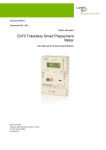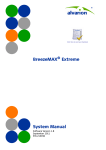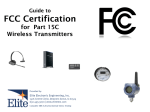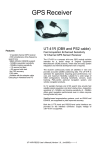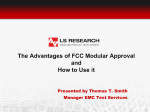Download 285076 D01 HAC Guidance v04 - Rhein Tech Laboratories, Inc.
Transcript
Federal Communications Commission Office of Engineering and Technology Laboratory Division October 31, 2013 Equipment Authorization Guidance for Hearing Aid Compatibility Introduction 1. This publication provides guidance to clarify the Hearing Aid Compatibility (HAC) equipment certification requirements for wireless handsets, 1 subject to Section 20.19 of the FCC rules. 2. Wireless handsets that provide Commercial Mobile Radio Service (CMRS) 2 telephone service using air interfaces and frequency bands for which technical standards are defined in ANSI C63.19–2007 and ANSI C63.19–2011 are subject to Section 20.19. 3 3. Manufacturers of wireless handsets that are seeking certification of a handset as hearing aid compatible 4 under Section 20.19 must submit, as part of the equipment certification process, a test report that demonstrates HAC compliance. Testing must be performed exclusively under either ANSI C63.19-2007 or ANSI C63.19-2011, as appropriate. It is not permitted to perform some of the tests on a handset under one edition and remainder with another edition of the standard. 4. Handsets subject to Section 20.19 are tested using either ANSI C63.19–2007 or ANSI C63.19–2011 under the following conditions: 1 The term handset, as used in this document, refers to a handheld device granted under a specific FCC ID and not to multiple model variations marketed under one FCC ID. This document will note when a new distinctive model designation is required, when multiple HAC ratings have been given under the same FCC ID (also see footnote 4). 2 See PART 20—COMMERCIAL MOBILE SERVICES (CMRS). CMRS is a service provided by a carrier that offers realtime, two-way switched voice that is interconnected with the public switched network and utilizes an in-network switching facility that enables the provider to reuse frequencies for subscriber calls in the 698 MHz to 6 GHz frequency band. 3 See Third Report and Order (DA 12-550, April 9, 2012), adopted the use of ANSI C63.19–2011 for HAC testing and became effective August 18, 2012. 4 Service providers and manufacturers are required to make available (providers to customers and manufacturers to providers) a number or percentage of Hearing Aid-Compatible (HAC) handset models out of the total number of wireless handsets it offers in the United States or imported for use in the United States, that are used for the delivery of the digital Commercial Mobile Radio Service. The number is defined by a schedule in Section 20.19(c) and (d). Manufacturers and providers must also submit to the Federal Communications Commission Wireless Telecommunications Bureau (WTB) regular reports demonstrating compliance pursuant to a reporting schedule set out in Section 20.19(c) - Reporting Requirements. The handset (model/FCCID/HAC Rating/standard-version/availability) reported to the WTB must be validated by the supporting test report exhibits (FCC ID/HAC Rating/standard-version) in the Equipment Authorization System (EAS). There is no requirement that the grant of certification and HAC report exhibits include an up-to-date model designation in the EAS for each model reported to the WTB. 285076 D01 HAC Guidance v04 1 a. Handsets that have modes and band(s) limited to those defined within ANSI C63.19-2007 may use either ANSI C63.19-2007 or ANSI C63.19-2011. b. Handsets that have modes and band(s) defined within ANSI C63.19-2011 (i.e., not addressed in ANSI C63.19-2007) can only use ANSI C63.19-2011 to demonstrate compliance. 5. Voice over IP transport for CMRS over network interfaces included in C63.19-2011 need to be tested or addressed for HAC compliance. See companion attachment “285076 D02 T-Coil testing for CMRS IP” to this KDB (285076) for further guidance and exemptions. 6. Handsets that only operate in bands that are not addressed in ANSI C63.19-2007 or ANSI C63.192011 are not subject to Section 20.19 HAC requirements. Equipment Certification Filing Requirements 7. The HAC test report exhibit must be submitted with a Form 731 application for equipment authorization, either as an original application, or as a Class II Permissive Change application to add or change the HAC rating of a handset subject to Section 20.19. 8. A Form 731 application associated with a HAC-tested handset must include a test report exhibit(s) which contains one complete M test report for each model marketed and reported as an M#, or one complete M-report and one complete T-report (see example in appendix A) for a model marketed and reported as M#T#. 9. Any handset supporting CMRS service that is designed to be held to the ear is considered a handset under Section 20.19. This includes any handset, even if the manufacturer claims that usually, or most often, users will operate it in a speakerphone mode or other mode. If a device cannot be practically held to the ear for voice communication, it is not subject to the HAC requirements of Section 20.19. This includes devices that provide voice communication only through a speakerphone, headset or other method or accessory. 10. Concurrent connections or services are modes that permit active voice calls at the same time with other active connections for data or other voice calls. For the purpose of this document, ”concurrent connections” are defined into two categories (1) “Concurrent connections” using simultaneous transmissions; and (2) “Concurrent connections” using other modes (not using simultaneous transmissions. a. Handsets that that have the ability to support “concurrent connections” using simultaneous 5 transmissions shall be independently tested for each air interface/band 5 Concurrent simultaneous transmissions (defined for this document) means: transmitters that are radiating simultaneously, establishing independent concurrent connections, operating over separate or the same air interfaces/bands, such that each air interface/band transmission is contributing to the radiated field. Until measurement procedures are provided for simultaneous transmissions, results for devices offering this capability are not required to be tested in the simultaneous transmission mode. Note: transmitters radiating simultaneously, establishing a single bonded connection, are not considered concurrent simultaneous transmissions and must be evaluated. 285076 D01 HAC Guidance v04 2 given in ANSI C63.19-2007 or ANSI C63.19-2011 separately. At the present time the ANSI C63.19 standard does not provide simultaneous transmission test procedures. b. Handsets that provide “concurrent connections” using other modes such as time division multiplexing over the same air interface with an air interface/band(s) given in ANSI C63.19-2007 or ANSI C63.19-2011 shall be tested in both modes (non-concurrent and concurrent) to determine the worst-case mode for applying the HAC rating. The worstcase mode shall be documented in the test report. c. All air interfaces/bands that can be operated in concurrent connections mode with another air interface/band (simultaneous transmission or other “concurrent connection” mode) shall be indicated in the test report. The test report shall identify the mode (simultaneous transmission or other) and the operation with which the indicated mode is concurrent. 11. Manufacturers that qualify for the Global System for Mobile communications (GSM) 1900 MHz band power reduction option 6 and provide test results where the HAC rating is based on reduced power in the 1900 MHz band, must provide in the Form 731 application filing a statement documenting that they are qualified, and must document the required information in the test report and user’s manual exhibits. 12. A Form 731 application for certification that shows test results in the M4 or M4T4 category cannot declare a lower rating (M3, M3T4). In all cases, the test report must have test results demonstrating the same rating declared by the manufacturer and reported to the Wireless Telecommunications Bureau. Test Report Exhibits 13. Test reports shall include the items indicated in Appendix A. 14. In addition, test reports shall include a matrix list of Air Interfaces and Bands (M and T report see Appendix B example): a. A list of all air interfaces and bands supported by the handset, indicating Air interfaces/frequency bands that are defined in ANSI C63.19-2007 or ANSI C63.19-2011 (that are and are not tested). b. For each air interface indicate the type of transport mode i.e.: VO=CMRS Voice Service; DT=Digital Transport only (no voice); VD=CMRS IP Voice Service and Digital Transport. c. When T coil testing is excluded in accordance with attachment KDB 285076 D02 T-Coil testing for CMRS IP (section 4.1 Applicants excluding T-Coil Testing for CMRS Voice over IP transport), include the following note (in the test report) that the air interfaces that have not been tested: “No associated T-coil measurement has been made in accordance 6 The option to meet the M3 HAC standard through a user-selectable power reduction for GSM operations in the 1900 MHz band (Section 20.19(e)(1) (c)) is available only to entities that otherwise would have qualified for the de minimis exception but must offer one hearing aid-compatible handset because of their size (See Section 20.19 (e) (1) (B)). 285076 D01 HAC Guidance v04 3 with the guidance issued by OET in KDB publication 285076 D02 T-Coil testing for CMRS IP”. d. Air interface/bands that operate in simultaneous or concurrent service modes transmission mode. e. All modes that may support Over the Top Voice transport modes that cannot be tested. f. If the GSM air interfaces in the 1900 MHz Band was tested using the option to reduce the power, state in the test report the maximum power in the 1900 MHz band and the reduced power used for testing compliance to demonstrate compliance to the requirement that power be reduced by no more than 2.5 dB. 15. MIF evaluation section (M report) C63.19 -2011 a. If the MIF values are tested, a description of the method and test equipment (manufacturer and model number) used to establish the Modulation Index Factor (MIF) as defined in Clause 5.5.1.3 of the C63.19-2011 standard. i. Provide any justification for MIF values if the value is less than the sample values expected in annex D.7 table D.5 and values approaching the margin. b. If the handset uses the MIF vales predetermined by the test equipment manufacturer: i. Provide a separate exhibit or attestation, signed from the applicant (device manufacturer) that the values used represent worst-case Air interfaces and Operation of the device; list the same MIF value specified by the test equipment manufacturer in the test report. ii. For the MIF values used, document the version number/version date of the MIF values provided (manufacturer files, etc.) and the supporting documentation for the related (version number/ version and date) values. c. When T coil testing is excluded in accordance with attachment KDB 285076 D02 T-Coil testing for CMRS IP (section 4.1 Applicants excluding T-Coil Testing for CMRS Voice over IP transport), the M rating at the acoustical location (either tested or rated M4 under the low power exemption of ANSI C63.19-2011, clause 4) can be included in the report but should be noted(*) in the Detailed Measurements section * “ T-coil measurement has not been made in accordance with the guidance issued by OET in KDB publication 285076 D02 T-Coil testing for CMRS IP” for that air interface. 16. A PBA is required in the event an applicant performs and submits T-coil tests in accordance with attachment KDB 285076 D02 T-Coil testing for CMRS IP (section 4.2 Applicants testing T-Coil for CMRS Voice over IP transport). Grant Note Codes 17. Use a grant note code of “HC” in the grant note field for the frequency bands and air interfaces for which the tests have been conducted and HAC rating obtained. a. When only T coil testing is excluded in accordance with attachment KDB 285076 D02 TCoil testing for CMRS IP, use only the grant note HC. It is not necessary to also use the 285076 D01 HAC Guidance v04 4 grant note HX, even if the same interface supports Over the Top (non-CMRS) voice (unless the condition in the following note apply). 18. Use the grant note code “HX” for the air interfaces that only have the ability to support Over the Top (non-CMRS) voice over data applications that have not been tested. Grant Comments 16. Add the text indicating the HAC rating in the comment field: “HAC Rating M# or M#T#-20YY (2007 or -2011)”. 17. When multiple models 7 that have been offered4 with different HAC ratings under the same FCC ID, the HAC ratings must list the ratings for each model: “M#T#-20YY, M#T#-20YY”.8 It is not required to list the actual model associated with the multiple ratings. 19. For air interfaces/bands included in ANSI C63.19-2007 or ANSI C63.19-2011 that have voice capability and are certified for HAC (for which the grant note “HC” is used) the following grant comments will be automatically added: “This equipment complies with the hearing aid compatibility technical requirements of Section 20.19 of the rules” 20. When T-coil testing is excluded, in accordance with the guidance issued by OET in KDB publication 285076 D02 T-Coil testing for CMRS IP add the following text manually: “Some T Coil tests have not been performed as permitted by the Commission policy”. 21. For air interfaces/bands that have voice capability (for which the grant note “HX” is used) the following grant comments will be automatically added: “This mode of operation has the means to permit held to the ear telephone calls but has not been tested for hearing aid compatibility. The device supports other modes which have been found to be compliant with the HAC rules.” 22. If the HAC rating requires a user-selectable mode reducing the power for the GSM air interface in the 1900 MHz band, then the following grant comment text shall be added: “HAC rating requires user activation of a special mode for GSM operation in the 1900 MHz band.” 7 The grant comment must list all HAC ratings for handsets under one FCC ID that have been offered and reported to the Commission as HAC-compliant. The format is “HAC Ratings: M#T#-200N, M#T#-20YY” after the (:) with each distinctive rating/model separated by a (,). When a permissive change has been granted for a new distinctive model the new grant comment shall list all the HAC ratings offered under the one FCC ID even if the previous model is no longer available from the manufacturer. 8 The grant comment “HAC rating only evaluated for the specific configurations described in this filing” is no longer required. 285076 D01 HAC Guidance v04 5 Manual and Disclosures 23. The user manual shall include the required disclosure statements as specified in Section 20.19(f). This includes, as appropriate: a. Section 20.19(f)(1): an explanation of the ANSI C63.19 rating system; b. Section 20.19(f)(2)(i) specified disclosure “Section 20.19(f)(2)(i), for handsets’ certified under ANSI C63.19–2011 and not tested for T-Coil operations in accordance with the guidance issued by OET in KDB publication 285076 D02 T-Coil testing for CMRS IP, require disclosure that the handset does not meet the relevant rating(s) with respect to such operation(s). 9 i. This phone has been tested and rated for use with hearing aids for some of the wireless technologies that it uses. However, there may be some newer wireless technologies used in this phone that have not been tested yet for use with hearing aids. It is important to try the different features of this phone thoroughly and in different locations, using your hearing aid or cochlear implant, to determine if you hear any interfering noise. Consult your service provider or the manufacturer of this phone for information on hearing aid compatibility. If you have questions about return or exchange policies, consult your service" c. Section 20.91(f)(3): disclosure statement for HAC-rated handsets operating over the GSM air interface in the 1900 MHz Band with a user-selectable mode of a special mode necessary to meet the hearing aid compatibility standard for reducing the power under the provisions of Section 20.19(c)(1). Permissive Changes, Product Changes and Model Variations 24. Multiple compliance reports under one FCC ID that represent distinct models 10 with different HAC ratings are permissible. 25. A Class II permissive change application must contain a complete HAC compliance report for all applicable air interfaces/bands. 26. A Permissive Change is permitted for multi-band and multi-mode handsets that were previously tested under ANSI C63.19-2007 and can now be tested under ANSI C63.19-2011 to include all the additional bands and modes. The new standard must be used to test all the modes and air interfaces covered in ANSI C63.19-2011. If the HAC rating changes, then a new model designation must be assigned to ensure distinction from the prior version. 9 Consult WTB for further information on specific cases. 10 Distinct models are defined in Section 20.19(a)(3)(iii). If a manufacturer assigns different model designations solely to distinguish units sold to different carriers (for either the same or different FCC ID), or to signify other distinctions that do not relate to either form, features, or capabilities, such designations shall not count as distinct models for purposes of compliance to the required schedules set out in Sections 20.19(c) and (d). 285076 D01 HAC Guidance v04 6 27. Any changes 11 that affect the HAC rating must be reported as a Class II permissive change. The handset must be given a new model designation distinct from that of the prior version of the handset. 28. A Class II permissive change application that only includes an M rating report for a handset previously granted with a rating of M#T# is only acceptable if (1) the handset is no longer to be marketed or reported with a rating of M#T# as a distinctive new model; or (2) as a distinctive new model. The grant comment associated with the Class II permissive change would then be “HAC Ratings: M#T#, M#”, for examples 1 and 2, respectively. 29. When adding a T-coil rating for a device according to the Class II permissive change procedures for handsets, a complete M-report and a complete T-report must be submitted with the Form 731 application. Only if there has been no product change to add the T-coil or the T-coil is at the same location as the acoustical output location (see clause 5.5 of ANSI C63.19-2011) then the previously filed report can be resubmitted. 30. If the manufacturer builds the product with alternative components, it must be tested to show compliance using the components representing the worst-case situation, according to the guidance for the permissive change procedure. 12 Features to be Tested 31. HAC Test environments (probes, equipment, test fixtures, etc.) must be properly calibrated according to the manufacturer and ANSI C63.19 requirements. 32. Testing must be done in accordance with ANSI C63.19 under the worst-case operating mode (highest interference potential). 33. No external special parts or ancillary devices are permitted in order to demonstrate HAC compliance. 34. Handset models with user instructions that disable any of its features, degrade performance, reduce RF output power, degrade battery performance, etc. for the purpose of meeting HAC compliance are not permitted. However, power reduction is permitted for the GSM air interface in the 1900 MHz Band for certain manufacturers of handsets using a user-selectable mode of reducing the power by no more than 2.5 dB under the provisions of Section 20.19(c)(1). Handsets using this provision must be noted in the test report and provide the appropriate text in the grant comment field and disclosure statements. 11 Any type of equipment modification (antenna position, design, metallic surface, adding system processes, changing battery capacity or type, etc.) has the potential to change the rating. The manufacturer must evaluate the equipment modification to determine if there is a change in the rating and if a Class II permissive change is required. Equipment changes that do not result in a change of the HAC rating being marketed and reported to the WTB do not require a Class II permissive change Form 731 application, and can be considered a Class I permissive change. 12 Permissive Change Policies, KDB 178919 Appendix A, 285076 D01 HAC Guidance v04 7 35. Certain User control and settings may be acceptable for processing audio signals in accordance with ANSI C63.19-2007 or ANSI C63.19-2011 requirements, in order to improve the performance for people with hearing loss. A clear description of these controls must be provided in the test report submitted with the application. 36. The antenna must be tested in a position of maximum antenna efficiency for voice operation, when the handset is held to the ear. When the handset can be used in more than one position, for example, with antenna stowed or extended, keyboard extended, etc., only the position of maximum antenna efficiency for held to the ear voice calls, as defined by the manufacturer, must be tested. All typical handset positions for held to the ear operation, which can result in an increase of the antenna efficiency, must be tested. 37. In addition to the air interfaces/bands documentation, the application shall document all other key features of the device tested, including: 13 a. Special HAC audio configurations permitted in accordance with ANSI C63.19-2007 or ANSI C63.19-2011; b. Statements regarding special antenna positions for HAC compliance (see Item 34 above). c. The applicant shall provide a general declaration, if specific transmission modes do not operate in the held-to-ear mode for providing handset service (i.e., held-to-ear modes do not include Wi-Fi or Bluetooth profile). d. Use of any feature, not discussed above, that is disabled during testing must be clearly documented in the test report. 38. For interpretations and explanations issued by C63®, see: http://www.c63.org/documents/misc/posting/new_interpretations.htm 13 An applicant has the option to submit the description of the EUT as a separate exhibit in the Operational Description, and request long term or short term confidentiality. 285076 D01 HAC Guidance v04 8 Appendix A: Example of Test Report The following items should be included in a HAC test report for a handset applying for certification under Section 20.19: 1. Summary 2. Air Interfaces and Bands 3. Test Site Description 4. Description of Test System 5. Equipment List 6. Description of EUT 7. Modes, Features and Capabilities for each model tested 8. Justification of Held to Ear Modes Tested 9. Test Procedure 10. Test System Validation, Calibration and Alignment Procedures 11. MIF evaluation ( M report) 12. T-Coil (T report) 13. Detailed Measurements (M and T Reports) 14. Measurement Uncertainty 15. Calibration Certificates 16. References and Supporting Test Data 17. Detailed Test Measurement Plots 285076 D01 HAC Guidance v04 9 Appendix B Air Interface Band MHz Type C63.19 Tested VO Yes Simultaneous Transmitter OTT 850 GSM NA 1900 GPRS/EDGE Power Reduction BT and WI-FI DT NA VO Yes NA Yes NA 850 WCDMA (UMTS) BT and WI-FI 1900 HSPA NA DT NA BT and WI-FI 800 CDMA V0 Yes BT and WI-FI NA Yes BT, and WLAN Yes NA N0 BT and GSM, LTE, CDMA,WCDMA or GSM YES NA NA WI-FI and BT and GSM, LTE, CDMA,WCDMA or GSM NA NA 1900 700 850 LTE 1700 1 VD 1900 2450 5200 WI-FI 5300 1 VD 5500 5800 BT 2450 DT VO=CMRS Voice Service DT – Digital Transport VD=CMRS IP Voice Service and Digital Transport 1.= No Associated T-Coil measurement has been made in accordance with 285076 D02 T-Coil testing for CMRS IP 285076 D01 HAC Guidance v04 10 Change Notice 285076 D01 HAC Guidance v01 has been changed to a new revision under the same version to 285076 D01 HAC Guidance v01r01 Item 15 of 285076 D01 HAC Guidance v01 has been changed to (see Item 15 above) From - 15. Only held to ear modes need to be tested. The Form 731 application exhibits shall include a clear description justifying the features activated, or not activated, during testing. – of 285076 D01 HAC Guidance v01 Item 16 has been has been added (which was the second sentence of Item 15 of 285076 D01 HAC Guidance v01) Items 16 through 24 of 285076 D01 HAC Guidance v01 are now 17 through 25 of 285076 D01 HAC Guidance v01r01 12/15/2010: 285076 D01 HAC Guidance v01r01has been changed to 285076 D01 HAC Guidance v02 Major revisions have been implemented due to FCC 10-145 released August 5, 2010 and effective October 8, 2010 which revised the Hearing Aid Compatibility rules in Section 20.19. 01/25/2011: 285076 D01 HAC Guidance v02 has been changed to 285076 D01 HAC Guidance v02r01 Clarification to paragraphs 5, 11 and 12 has been made for using the grant note HX. 08/20/2012: 285076 D01 HAC Guidance v02r01 has been changed to 285076 D01 HAC Guidance v03. Major revisions have been implemented to reflect new rule changes effective August 18, 2012 by Third Report and Order (DA 12-550, April 9, 2012). 04/08/2013: 285076 D01 HAC Guidance v03 has been changed to 285076 D01 HAC Guidance v03r01. Clarification for reporting MIF values and VoLTE testing provided as indicated track changes shown as red markup. 06/18/2013: 285076 D01 HAC Guidance v0301 has been changed to 285076 D01 HAC Guidance v03r02. Note 5 was changed for Clarification to align the 12-month transition effective date until July 17, 2013 defined in 20.19(b) (3) (ii) of the rules. 08/26/2013: 285076 D01 HAC Guidance v0302 has been changed to 285076 D01 HAC Guidance v03r03. Revisions reflect additional guidance provided in by a new attachment 285076 D02 T-Coil testing for CMRS IP of this KDB. Key changes are shown as red markup. 10/31/2013: 285076 D01 HAC Guidance v0302 has been changed to 285076 D01 HAC Guidance v04. Revisions reflect further guidance provided for attachment 285076 D02 T-Coil testing for CMRS IP of this KDB. Key changes are shown as red markup. 285076 D01 HAC Guidance v04 11











